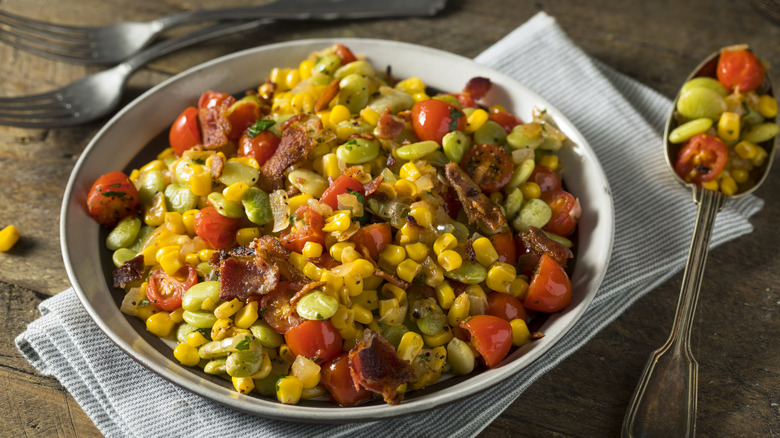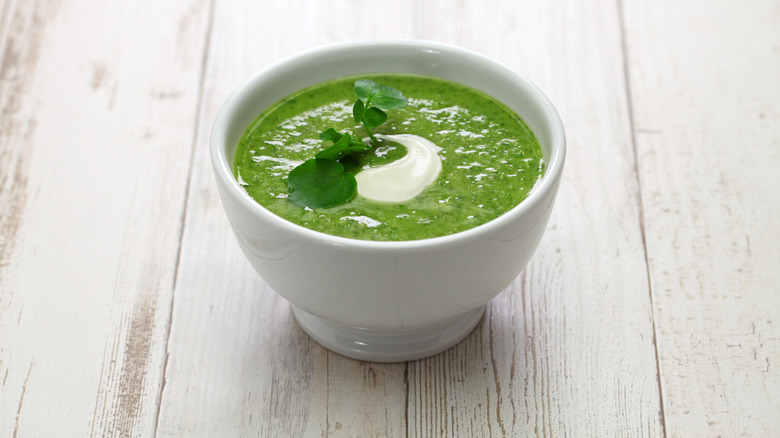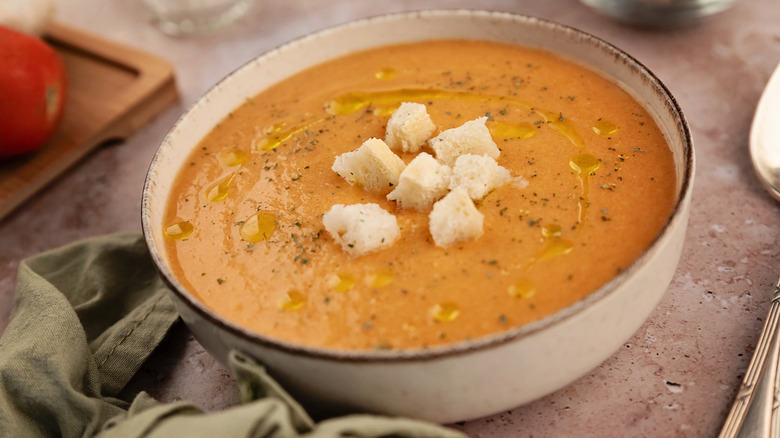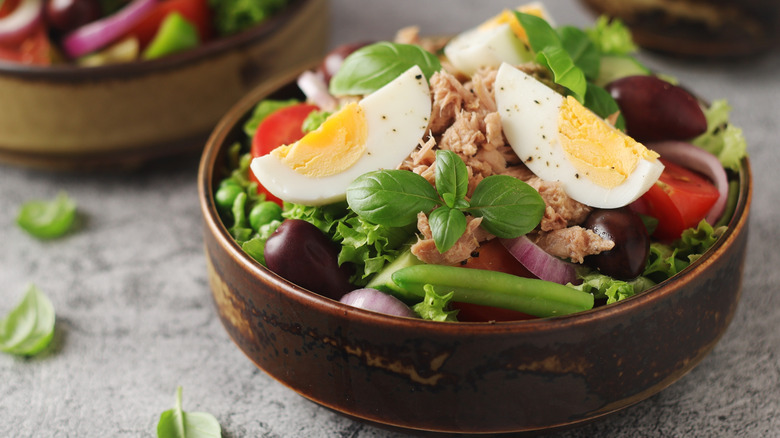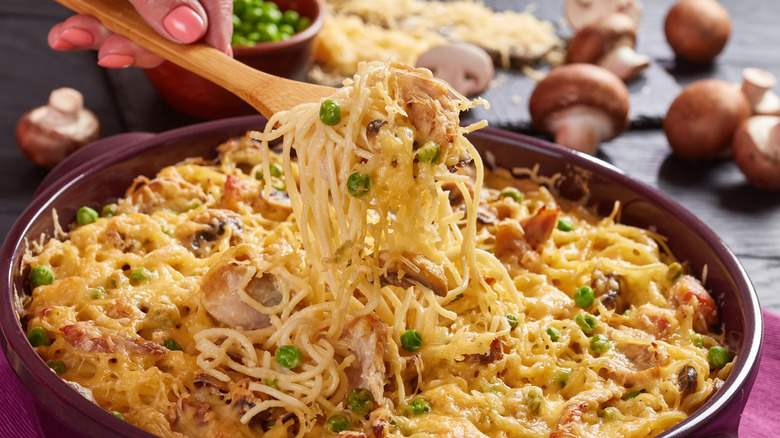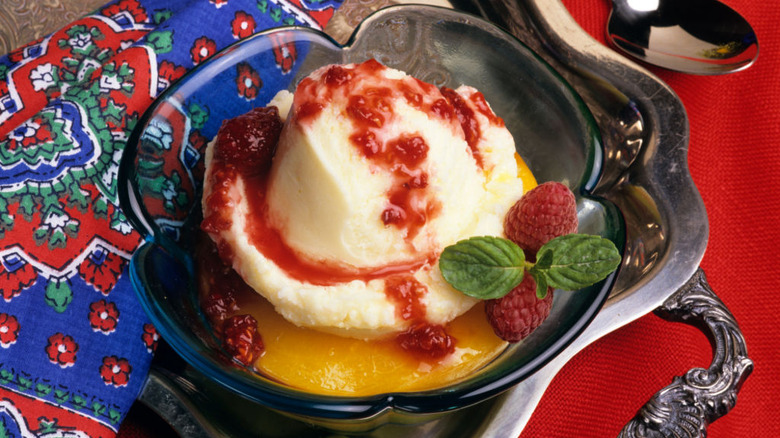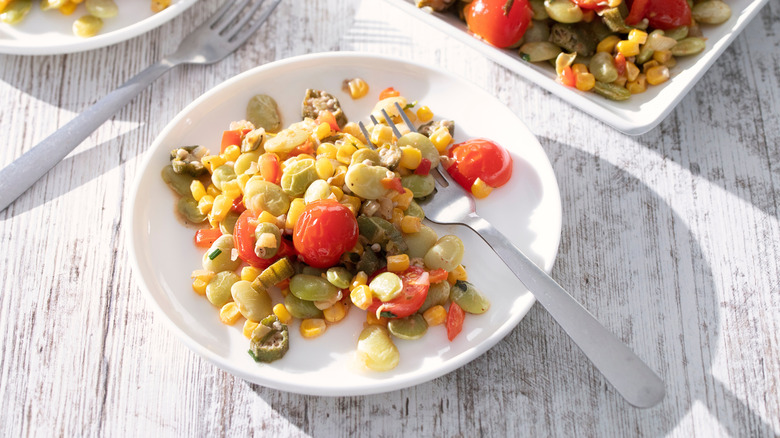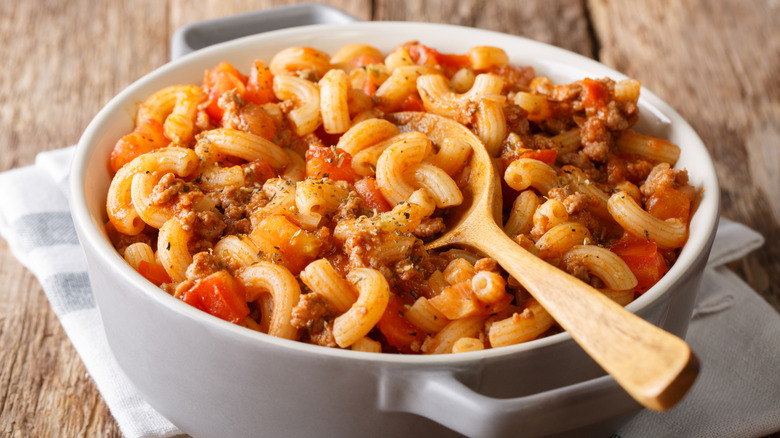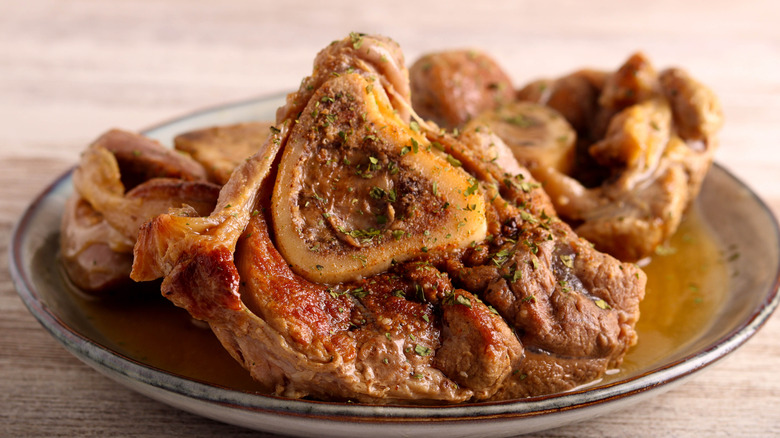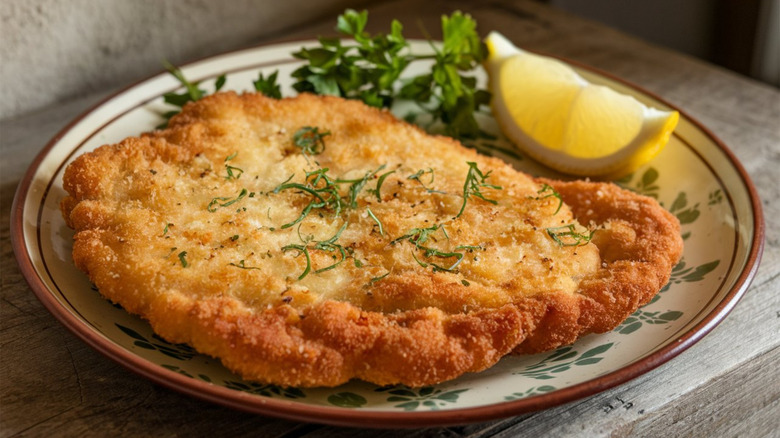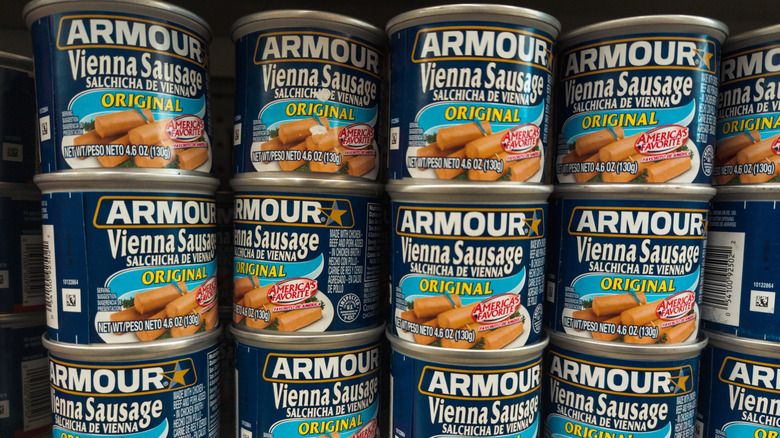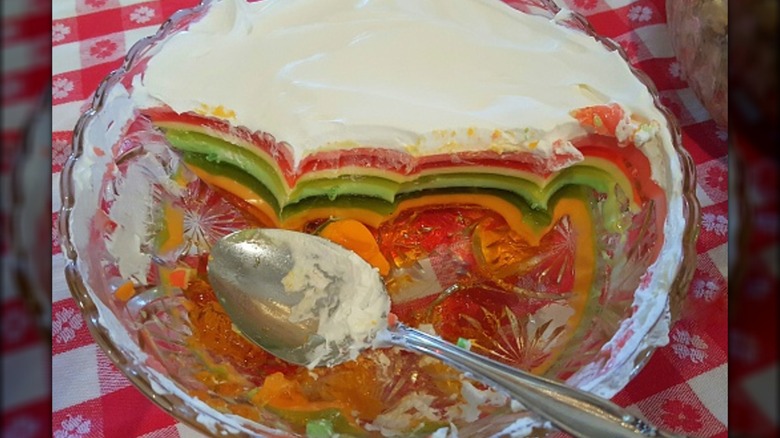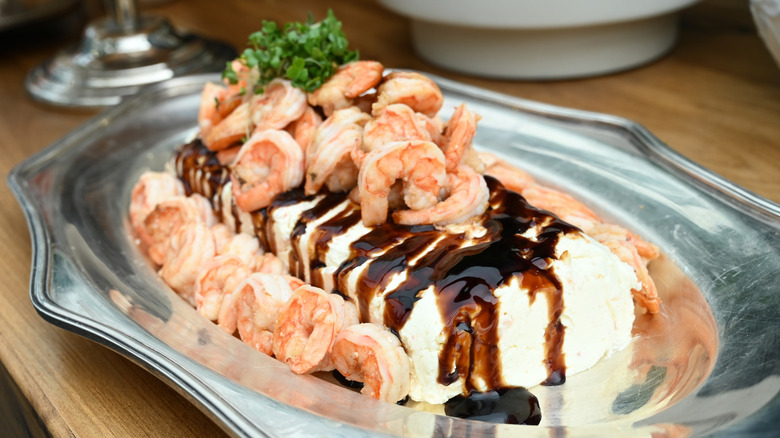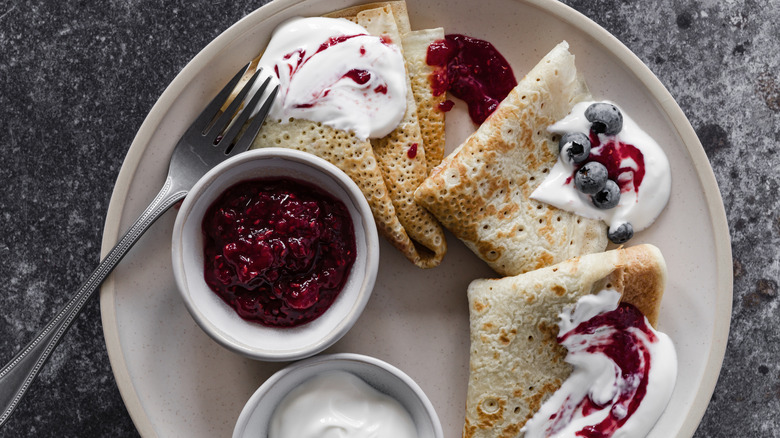Chefs Tell Us The 17 Old-School Foods They Wish Would Make A Comeback
Foods come and go. Sometimes, trends and fads inspire dishes like the cronut or milkshakes overloaded with dramatic toppings — dishes that experience meteoric rises to fame on social media, before their flames are snuffed out for good. Other times, foods grow in popularity due to necessity, as was the case with foods like vinegar pie, coming into the mainstream during the Great Depression, when ingredients were scant, or the English potato pie during the First World War, which fed soldiers on rations.
However they came to be, some once-popular vintage and old-school foods have been lost to history, and according to the professionals, they really ought to make a comeback, stat. We asked chefs and culinary experts from around the country what foods they personally wished would appear on menus again, and these were their thoughts.
Watercress soup
According to Chef Jey Kempin from the Auguste Escoffier School of Culinary Arts, watercress soup — or, as the French call it, "soupe au cresson" — has long been popular in England, France, and China. However, it's never really enjoyed the same long-lasting foothold in the United States, even though Kempin lovingly describes the soup as one of their favorites ever.
They said, "The first time I had Watercress Soup was at a country club dining room in the mid-90s, and I was hooked. I rarely see it on a menu, but if I do, I immediately order it. Aside from the fresh peppery flavor, watercress is known for being packed with important nutrients and antioxidants. This is an underused ingredient that I would love to see come back in a big way."
Though you can't find watercress soup on many menus now, you can make your own at home and, if you do, follow Julia Child's method for enriching watercress soup: adding two egg yolks and a half a cup of cream to up the soup's texture and flavor.
Cold soups
While watercress soup can be served either hot or cold, one chef told us that they'd like to see cold soup come back across the board. Chef Partner Taylor Ponte, who recently opened the sustainably-focused Aurum Maui, said cold soups like gazpacho are "underrated."
He said, "They're a great canvas for highlighting unique ingredients I'm excited about, and they're perfect in our island climate. I'd personally love an almond and olive oil gazpacho. Something simple, elegant, and refreshing."
For those who agree, making gazpacho at home couldn't be simpler, requiring minimal ingredients and taking advantage of some great, height-of-summer produce. However, if gazpacho doesn't quite catch your fancy, you do have other cold soup options. Vichyssoise is a classy cold potato soup that incorporates a fair amount of leeks, and borscht makes for a chilled summer soup you can't "beet." A lesser-known but also valid option is ajo blanco, a refreshing soup that's packed with pungent garlic.
Salad Nicoise
Once you make salad nicoise, named for the French city of Nice, there's no going back. Easy, straightforward, and brimming with a tantalizing mix of textures and flavors, it's far, far from a boring salad. Today's recipe can be traced to Auguste Escoffier, the French chef and culinarian born in 1846, and while the people of Nice might not claim Escoffier's recipe, the rest of the world has. A bed of lettuce meets new potatoes, green beans, hard-boiled eggs, tuna, and tomatoes, in a light vinaigrette.
"It's not just the ingredients, but the Dijon, herb, and champagne vinaigrette that make it!" described Chef David Cingari, executive chef of Cingari Family Markets, when laying out his love for this old-school salad. "Fresh tuna, crisp lettuce, garden veggies and a perfectly boiled egg instantly transport you to a Paris bistro or a beach cafe in Nice, France! I could go for one right now."
Tetrazzini
Chef Cingari also noted that tetrazzini — chicken or turkey, he's not picky — is an old-school dish that needs to make a comeback, noting that it was a dish his mother made all the time when he was a child, and it's something he still loves.
Alongside dishes like chicken a la king and chicken cordon bleu, chicken tetrazzini is definitely an underrated old-school chicken dish. If you're not familiar, tetrazzini is a pasta-based dish, created in San Francisco in the early 1900s. The dish supposedly takes its name from a famous opera singer of the time, Luisa Tetrazzini. At its simplest, tetrazzini combines spaghetti with chicken, peas, creamy sauce, and cheese, but you can make it more or less complex, depending on your leanings. For example, some might make the sauce from scratch, either a bechamel or Mornay sauce, but busy home cooks in decades past most likely just reached for a can of cream of chicken or mushroom soup to form their tetrazzini sauce.
Peach melba
For Auguste Escoffier School of Culinary Arts chef instructor Tammie Barnhill, peach melba provides a connection not just to her family, but also to her current work at Escoffier, as well as broader culinary history. Auguste Escoffier was the first to combine peaches with raspberry puree and vanilla ice cream, forming a simple but delectable dessert in 1893. Escoffier christened the dish "peach melba," after Nellie Melba, a famous opera singer of the day (and Escoffier would go on to name another creation after Nellie, too — melba toast).
Barnhill said peach melba was one of her family's favorites while growing up in Alabama. "Decades later, in September 2024, I found myself at the Auguste Escoffier Foundation Museum in Villeneuve-Loubet, France, the birthplace of this great chef," she said. "While there, I had the opportunity to enjoy peach melba as Escoffier intended — tender poached peaches, cool and creamy vanilla ice cream, with a vibrant and tart raspberry coulis. To sit in that courtyard, eating a dish Escoffier first created in the 1890s to honor the Australian soprano Dame Nellie Melba, was very nostalgic for me. It felt almost full circle — like my childhood memories and Escoffier's legacy all connected by this simple, yet timeless dessert."
Today, she added, peach melba deserves a comeback for a few good reasons. The dish's simplicity renders it ageless. It doesn't require any extravagant cooking techniques. It's seasonal and fruit-forward, and light enough to appeal to modern diners.
Goat cheese salad
Goat cheese had a moment in recent history. Once a niche product (at least in the United States), over the first decade of the new millennium, goat cheese became one of the fastest-growing specialty cheeses on the market, and by 2011, goat cheese was the fastest-growing market for goat milk. You could find goat cheese, primarily chevre, incorporated into appetizers, served in dessert, and, yes, on salads. Today, the goat cheese market is still growing, but a goat cheese-topped salad might not have the same chic appeal that it did in the 2000s. Still, Chef Staci Miller of The Victorian says we should change that.
"Last year," she recounted, "we hosted a series of dinners in homage to Alice Waters, and one dish that really struck a chord for me was her goat cheese salad. The marinated, crumb-crusted, and baked chevre paired with a simple greens salad was a pivotal flashback to my time cooking in San Francisco. It showed me how something so straightforward yet flavorful could be truly unforgettable — proof that simplicity, when done well, leaves the most lasting impression."
Succotash
For Oakland's Chef Rene Johnson, thinking about old-school recipes that could use a comeback brings up memories of her grandmother. One favorite dish from her grandmother's garden and kitchen? Succotash, a top old-school side dish that almost everyone has forgotten about. "Fresh tomatoes, fresh corn, [and] chopped okra fried in a skillet with just a little bit of salt and pepper and a pinch of sugar take it to the next level, simmering on the stove — simple, delicious, poured over rice, and oh-so-southern," said Johnson.
Succotash boasts a rich and long history, which makes it even sadder that this dish isn't on many menus nowadays. Originating with the Narragansett of New England, succotash could've very well found a place among the first Thanksgiving Day spread, and it was eaten widely throughout the American colonies in the 1600s. It was also popular during the Great Depression, as it's cheap and easy to make.
Goulash
Goulash is another cheap and easy-to-make dish that Chef Johnson wishes would make a comeback — and, also just like succotash, goulash, an old-school pasta dish that hardly anyone eats anymore, likewise boasts deep roots. It's worth noting, though, that goulash comes in two varieties.
The original Hungarian and Eastern European goulash is a slow-cooked beef dish with lots of paprika that can be served in a variety of ways, including over pasta, but also over rice or mashed potatoes, similar to a beef stroganoff. American goulash, meanwhile, is always a pasta dish, cooking ground beef with elbow macaroni, tomatoes, and cheese, for a hearty, rib-sticking dinner (paprika being optional in this variant). Both versions, unfortunately, aren't as familiar as they used to be, but reviving them takes little effort and, if you opt for a one-pot or Instapot recipe, little time at the stove or the kitchen sink.
Ratatouille
You know ratatouille from the movie of the same name, but when was the last time you actually saw this dish on a menu? Or made it at home? It's probably been a while, if at all. Still, ratatouille deserves a resurgence, according to Chef Eitan Bernath, who recently served as an ambassador for HelloFresh and No Kid Hungry's Hunger Hero campaign, aimed at raising awareness of childhood hunger in the U.S.
"Ratatouille is peak cozy-meets-beautiful — layers of colorful vegetables, perfectly roasted, and bursting with flavor," said Bernath. "It's a humble dish with incredible versatility, and it's basically the perfect way to celebrate seasonal produce while making something that looks almost too pretty to eat. Plus, you can watch the movie while eating it for the full experience."
While you're watching the film, make sure you're also taking notes. There are 15 cooking lessons you can learn from "Ratatouille," including the importance of making every second in the kitchen count and how to choose the best bread.
Veal ossobuco alla Milanese
Ossobuco, despite its relative simplicity, feels intimidating to many home cooks — and maybe that's one reason why it's not widely popular, unless you're in Italy or you manage to find it on the menu at a high-end Italian restaurant. Ossobuco, which translates to "bones with holes," likely came about in Milan in the 1800s. Veal shin is floured and browned, and diced vegetables and broth converge before it's all cooked low and slow, resulting in a supremely tender, succulent dish.
Chef Ryan Fichter of Elliott's Craft Kitchen theorizes that perhaps ossobuco alla Milanese has fallen out of mainstream favor due to the bad rap that veal has accumulated, noting that the meat is not on many menus outside of Italian fine dining, and you're unlikely to find veal in the average grocery store. "I think this is just a fantastic dish," he said, "with the subtle beef flavor from the veal, that is fall-of-the-bone tender, braised in a white wine and mirepoix. Pair it with a creamy saffron risotto and it is simply delicious."
Pork schnitzel
Pork schnitzel is another dish that Chef Fichter said deserves a resurgence. He mentioned that the Japanese dish katsu, which is chicken or pork cutlets breaded in panko crumbs and fried, recently saw a boost in popularity, so it wouldn't be out of the question for pork schnitzel to come back around as well. In fact, he plans on adding it to the menu at Elliott's Craft Kitchen himself.
Still, there are some differences between schnitzel and katsu. Katsu uses thicker cuts of pork, versus the pounded-out cutlets used for schnitzel. Additionally, katsu is often deep-fried, whereas schnitzel is typically pan-fried. Katsu uses panko breadcrumbs, whereas schnitzel uses more traditional bread crumbs. Also, katsu is usually served with a sweet dipping sauce that's made up of oyster sauce, Worcestershire, and ketchup, while schnitzel comes with another German favorite: potatoes.
If the need for a schnitzel comeback is no news to you, you might want to try making schliders, which is exactly what it sounds like: sliders made with schnitzel. You might also want to try your hand at something a little creative, like making schnitzel with Cool Ranch Doritos.
Vienna sausages
Ask anyone about Vienna sausages and you'll likely get some pretty strong responses. Either someone will tell you that you should avoid buying canned Vienna sausages altogether, due to the high levels of salt, fat, and cholesterol found in these little weenies, or you'll get a defensive exclamation that people need to stop crapping on Vienna sausages.
Chef Chaz Lindsay, owner and executive chef of Pulito Osteria and Rowan's in Jackson, Mississippi, falls firmly in the latter camp, saying that Vienna sausages are one of the top foods that he thinks should make a comeback. He told us, "Give me a better potted meat. It's the perfect snack. You just have to be mindful when getting the first one out of the can so you don't mess up the ends of the others. Texture is important."
While Vienna sausages may not hold the same popularity that they might've in decades past, you can still buy them at the grocery store, in the canned meat section. One of the most popular brands is Armour, which markets its Vienna sausages as a keto-friendly, low-carb, ready-to-eat snack perfect for survival or emergency disaster kits.
Jell-O salad
Jell-O salad was wildly popular in the mid-20th century, for many reasons. The recent advent of instant Jell-O allowed home cooks to craft previously laborious gelatin-based dishes with ease and affordability. Instant Jell-O was shelf stable. A Jell-O salad also allowed home cooks to be extra-creative and over-the-top during periods when domesticity and prowess in the kitchen was prized, but convenience and efficiency still mattered. With little time and using whatever they had on hand, home cooks could pull together an impressive-looking Jell-O salad in a snap.
In other words, there were loads of reasons why Jell-O salad was popular, and Chef Lindsay is of the opinion that these versatile salads should get another day in the sun. He specifically references his grandmother's Jell-O salad recipe, which the family called an Easter salad, simply because it was enjoyed every year on Easter. The recipe included green Jell-O, pecans, pineapple, and cottage cheese. "Acid, fat, crunch — it hit in all the right ways," said Lindsay.
Terrines
"I'd love to see terrines make a comeback," said Chef Partner Taylor Ponte. "They're such thoughtful, flavorful dishes that really showcase whole-animal cookery while allowing room to experiment with textures and spices."
A French dish in origin, terrines are layered, loaf-shaped dishes of meat, fish, and/or vegetables. They're highly versatile and can incorporate a vast array of ingredients, all cooked in a water bath to retain moisture. After cooking, terrines are sliced and served with various accoutrements. "Imagine a pork terrine with macadamia nuts, aromatic spices, passion fruit jam, and a punchy pickle," Ponte described. (Though, if you're looking for something unconventional, you can make a citrus terrine with just fruit, sugar, and gelatin.)
He recommends pairing your terrine with his favorite, lambrusco, a sparkling wine that enjoyed a surge of popularity in the 1980s, before falling out of favor. Today, it's just now regaining traction within the broader wine industry, if not with mainstream consumers overall.
Crepes
Crepes have been around a long time, and while the exact origin of these thin French pancakes is murky, it's pretty clear that the French have been eating crepes for hundreds of years. Americans latched onto the idea of crepes in the 1950s, primarily in the form of crepes suzette, a sweet variety featuring an orange juice and Grand Marnier-based sauce. Americans' take on crepes only grew from there, expanding into savory crepes. By the 1960s, a nationwide crepe-centric restaurant chain opened, dubbed the Magic Pan, with more than 100 locations. A New York Times restaurant review noted that the only major flaw at the Magic Pan was the overabundance of customers waiting their turn to enter the restaurant.
Now, you probably won't see a line stretching down the sidewalk to get some crepes, but Chef Ponte thinks crepes deserve a second chance. "I'll always be a fan of the classics, like crepe suzette, but I also enjoy seeing them reimagined with unexpected flavors. Say, a version infused with yuzu," he said. "They're versatile, timeless, and always bring a bit of fun to the table."
Tea cakes
When Chef Rene Johnson talks tea cakes, she's specific — she wants tea cakes like her grandmother baked, which she describes as "soft and sweet, carrying memories in every crumb." "This is a recipe I regret that I don't have from my grandmother," she added, "and I am afraid to make them, because I know they are not going to taste like hers. So, I just live in the memories of my grandmother's tea cakes."
If you're not familiar with tea cakes, it might be because they're pretty specific to the South and have declined in popularity. Whatever the reason, don't make the mistake of assuming southern tea cakes are cakes. Instead, they're cookies that reportedly evolved from the jumble cookie, which was popular from the 1600s to the 1800s. While tea cakes varied widely from family to family and baker to baker, you can think of a basic tea cake as slightly similar to a sugar cookie, relatively plain and with a soft, cake-y center and a crisper, light brown edge.
